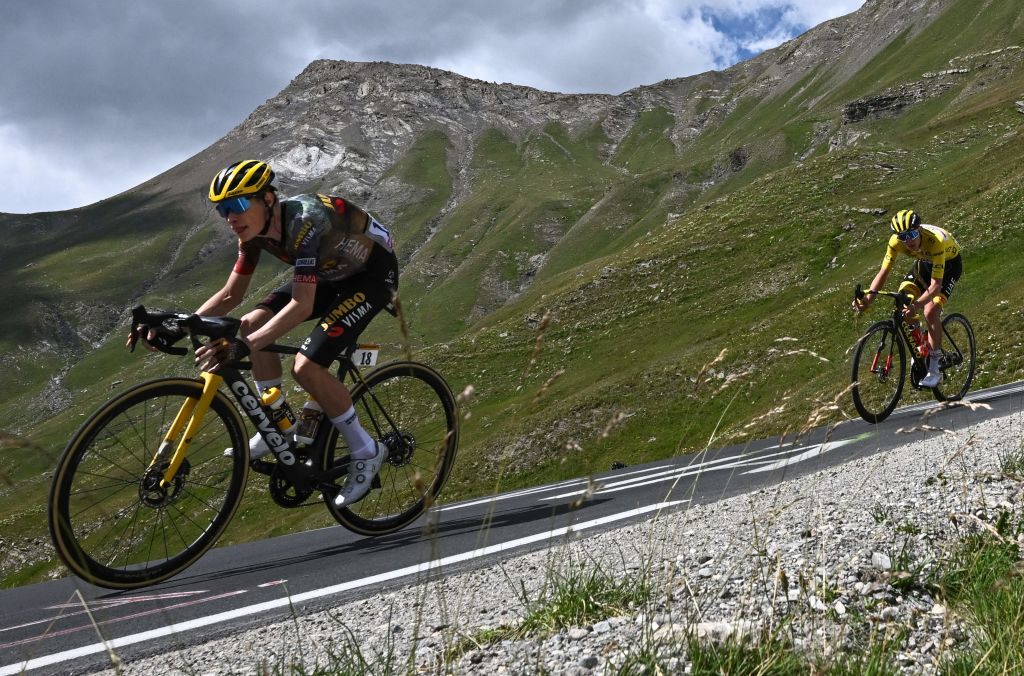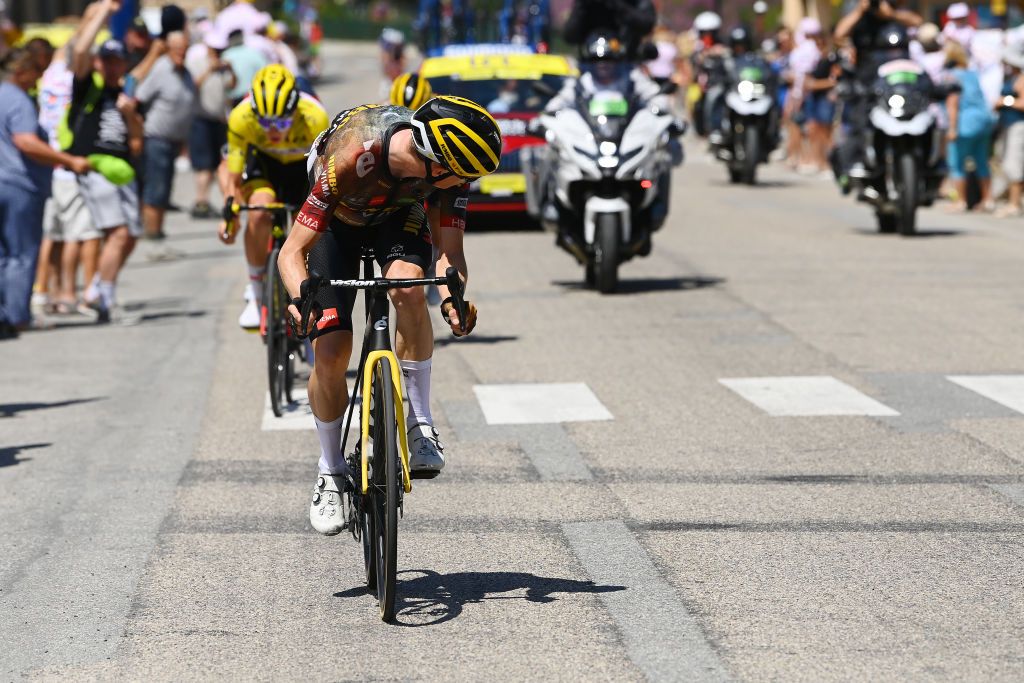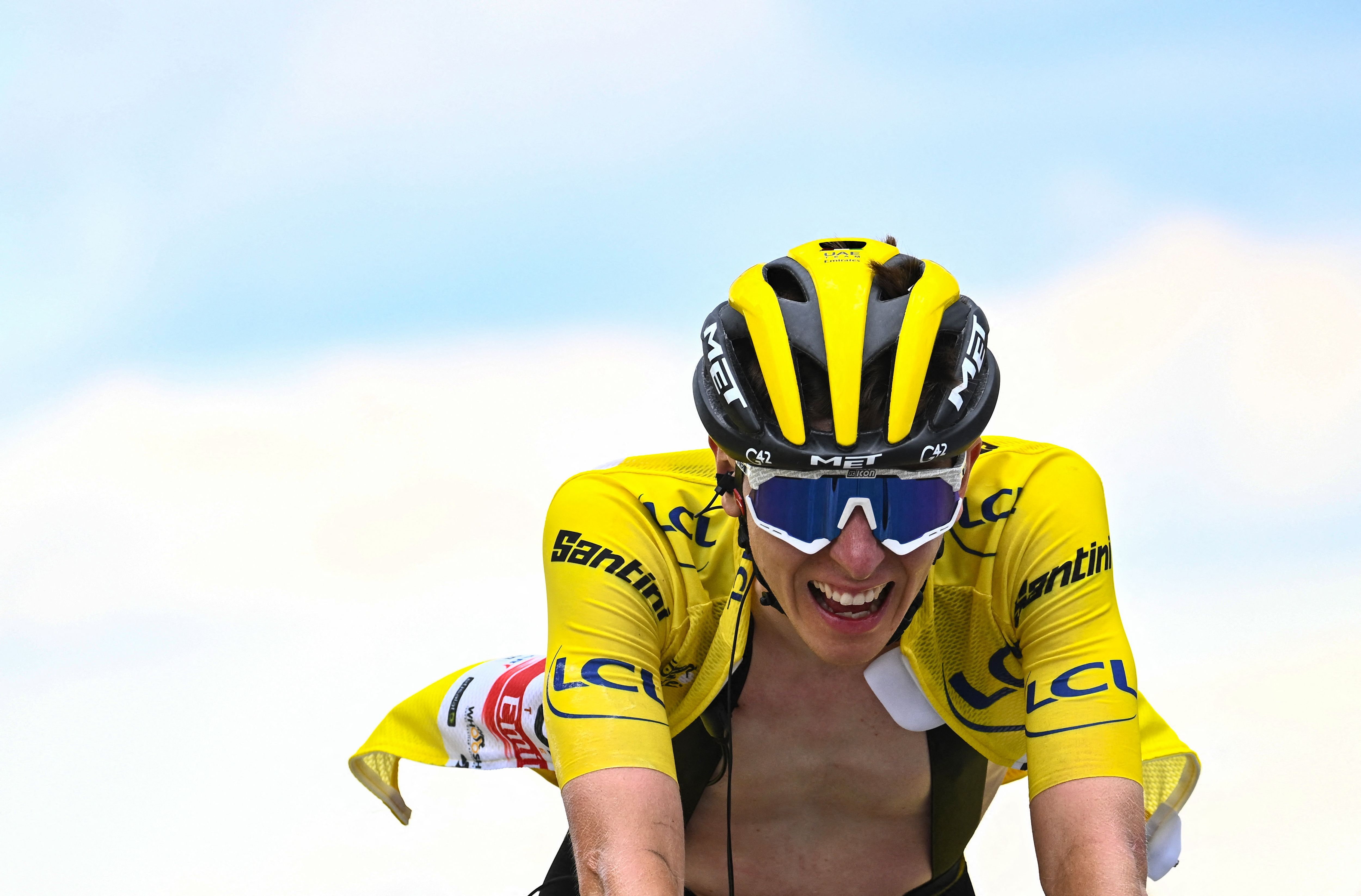What Happened To Tadej Pogačar?
The cause - or causes - of Tadej Pogačar's first full TdF crack in three years will decide if he can still fight for Yellow in week three.
For the first time in a stage race in maybe his entire pro career, Tadej Pogačar looked truly cooked. When Jonas Vingegaard attacked 4km from the summit of the Col du Granon on Stage 11 of the Tour de France, the two-time defending Tour champion was instantly in difficulty, and didn’t even really try to follow.
It was a stunning collapse. Pogačar had been under sustained attack from Vingegaard’s Jumbo-Visma team for much of the day but had held tough. He even mugged for the TV camera a bit just before the final climb of the Granon.
Then, in just four kilometres of road, it all fell apart: face flushed, jersey flapping wide open, rocking uncomfortably back and forth on the pedals, and losing time in chunks. Vingegaard’s attack was world-class, no doubt: estimates are that for his final 15-minute assault, he sustained 6.1 watts of power per kilogram of body weight, a massive workload after four hours of a bloc racing. Pogačar, by contrast, could only manage 5.2w/kg, well off his potential, and finished in 17:51. In a sport decided by a few seconds here or there, he was 17 percent slower.
READ MORE Who The Hell Even Are You Tadej Pogačar?
Speculation immediately lit on why. The wicked pace and lack of teammates around him had upset his fuelling strategy, or maybe hydration. He got overheated on the climb and cooked himself. Or he’d just dug too deep all day responding to the attacks and had nothing left. A final theory: COVID is running rampant through his team, and maybe Pogačar is the next case.
Pogačar himself seemed initially unsure of what exactly had gone wrong. “Maybe I was under-fuelled today or I just had a bad day,” he said at the finish. But less than 24 hours later, with the likely benefit of a debrief with his UAE-Team Emirates sports science staff, Pogačar allowed, “I know why I cracked yesterday,” and intimated he was “maybe too stupid” to have set the pace on the Galibier.
 So what was it? The answer might not be as easy as one explanation or the other; a bonk or overheating isn’t mutually exclusive from having done too much work, for example. But the degree to which each was a factor could tell us something about whether Pogačar can mount a big fight for yellow or is destined for a slow fade, or worse.
So what was it? The answer might not be as easy as one explanation or the other; a bonk or overheating isn’t mutually exclusive from having done too much work, for example. But the degree to which each was a factor could tell us something about whether Pogačar can mount a big fight for yellow or is destined for a slow fade, or worse.
Did He Forget to Eat?
The smallest contributor was likely fuelling and hydration. Jumbo’s constant attacking had two effects: it left Pogačar isolated, largely without teammates to bring him food and drink. A domestique, Allen Lim told Bicycling, is “the guy giving up a bottle, a bar or a gel, going back to the car. You can’t underestimate the impact of not having a good domestique has on your fuelling ability.” You might know Lim as the cofounder of sports nutrition company Skratch Labs and a cookbook author. He’s an expert on sports nutrition, but he’s also a Ph.D. sports physiologist and former sports scientist for what is now the EF WorldTeam, and also worked with Lance Armstrong and Floyd Landis.
The second effect of the relentless pace was to make it harder for Pogačar to visit the team car himself to take on supplies. When a pack is shedding riders on narrow, winding roads like in the Alps, it can take time for the support cars to make their way through the field to the front. They can be hundreds of meters behind their team leader, which pretty much rules out dropping back until the car can work through the dropped riders and catch up.
But Pogačar’s crack didn’t purely look like a full-on bonk or hunger flat to Lim, because Pogačar was still able to put out decent power after he got dropped instead of pedalling squares. “Fatigue is multifactorial,” Lim says, as a warning against trying to guess from afar what led to Pogačar’s weakness. “Once a muscle is fatigued it can be because there’s not enough fuel, or it’s no longer metabolising fuel correctly. Or it’s overheated and the central nervous system is starting to take protective action.”
Was It the Heat?
Ah yes, overheating. Food, Lim observes, isn’t the only thing racers get from the team car; on hot days, teams also carry ice socks: nylon hosiery packed with ice, which riders stuff down the back of their jersey. Team cars also hand up cold water bottles for riders to douse themselves with. Pogačar simply might have overheated because he wasn’t able to get enough water and ice. That Pogačar was riding with an “open jersey, when others did not do so, is telling,” noted Lim.
 The nearest weather station to the Col du Granon summit road is about six kilometres southeast down the Durance valley in Briançon, and records show it was 33 degrees there at the time riders started the climb. But air temperature drops about two degrees for every 300m rise in elevation, and the Granon finish is almost 2 700 feet above sea level and nearly 4,000 feet higher than Briançon. So it would have been a pleasant low twenties on the highest parts of the climb, and although the Granon’s upper slopes are south-facing and exposed, high clouds had moved in by that point, limiting the worst effects of any direct sun.
The nearest weather station to the Col du Granon summit road is about six kilometres southeast down the Durance valley in Briançon, and records show it was 33 degrees there at the time riders started the climb. But air temperature drops about two degrees for every 300m rise in elevation, and the Granon finish is almost 2 700 feet above sea level and nearly 4,000 feet higher than Briançon. So it would have been a pleasant low twenties on the highest parts of the climb, and although the Granon’s upper slopes are south-facing and exposed, high clouds had moved in by that point, limiting the worst effects of any direct sun.
But the effect of heat on exercise capacity has mostly to do with body temperatures, both core and skin, and exercise-related heat stress can happen in moderate temperatures. The human body is only about 25 percent efficient at converting stored energy (fat and muscle glycogen) into mechanical work; the rest is dumped as heat. So to produce the 400-odd watts that a 65-kilogram rider like Pogačar would require to match Vingegaard’s attack, he would need to sustain 1 600 watts of total metabolic work, 1 200 watts of which is heat production that his body has to shed (mostly via sweat) so it doesn’t cook.
“Think about having a toaster on in your gut,” says Lim of the level of heat being produced with that kind of effort. In exercise physiology, the cardiovascular system does two things: deliver oxygen to muscles, and remove metabolic waste, which includes heat. “The performance bottleneck for these athletes, with so much power, is not always the delivery of oxygen, but the removal of heat,” notes Lim.
As core body temperature rises past around 39.5 degrees and skin temperature increases along with it, the body tries to protect itself by limiting work rate: power output drops—progressively as core and skin temps rise further—and exhaustion sets in more quickly. In one 2010 study coauthored by Michael Sawka, an expert in physiology in extreme environments, work rate in hot conditions decreased by 17 percent compared to more normal temperatures. Dehydration can make that worse.
Was His Body Just Beat?
So heat and hydration might have played a role. But if it had been only that, Pogačar likely would have showed signs of struggle earlier; it’s rare that athletes go from fine one moment to cooked the next from heat stress alone. And he seemed to manage just fine on the Stage 14 finish in Mende, a hot, sunny climb (albeit shorter), although at the finish his shorts were heavily stained with salt deposits while Vingegaard’s kit looked fresh. Which brings us to the final sports physiology explanation: the intensity just wore him down.
 Pogačar’s team manager, Mauro Gianetti, told reporters that he thinks Pogačar went too deep defending against attacks and, crucially, trying his own move on the Galibier, the penultimate climb. That, Gianetti said, meant Pogačar didn’t have enough left over for the final few kilometres. Pogačar’s own comments the day after his crack suggested much the same.
Pogačar’s team manager, Mauro Gianetti, told reporters that he thinks Pogačar went too deep defending against attacks and, crucially, trying his own move on the Galibier, the penultimate climb. That, Gianetti said, meant Pogačar didn’t have enough left over for the final few kilometres. Pogačar’s own comments the day after his crack suggested much the same.
A common analogy of the cost of repeated accelerations is a matchbook. You only have so many matches, the idea goes, and when you’ve lit them all, there’s nothing left. While that sounds perfectly reasonable, it’s not the best way to think about what’s happening because a matchbook can’t be replenished, said Dr. Philip Skiba, the director of sports medicine for Chicago-based healthcare system Advocate Aurora Health.
The better analogy, he told Bicycling, is a battery. Every athlete has a maximum power output that they can sustain more or less indefinitely. That’s called Critical Power. The battery is the athlete’s capacity for work above that threshold, and it goes by the scientific name W’ (say W Prime).
W’ has been pretty well-established for decades, says Skiba, who is also doctor for USA Cycling’s national team and consulted on Nike’s Breaking 2 marathon project. Broadly, when you’re working harder than your Critical Power threshold, you’re tapping the battery, and below CP, you’re replenishing it.
His contribution was to devise a physiological model for understanding how the battery drains and is recharged, called W’ Balance, sometimes shorthanded as W’BAL. This model, which Skiba started to articulate about 15 years ago, is now widely accepted; you might even be familiar with it from power training software if you use a power meter.
“The size of that battery is very limited,” says Skiba, and the catch is that in most racing situations, W’BAL drains faster than it recharges. “If you’re freewheeling downhill it’s recharging quite quickly, but if you’re riding 10 watts below your (CP) threshold, it’s hardly recovering at all, because you only have that 10 watts of space to put into the recharging process.”
Jumbo’s strategy, says Skiba, amounted to using repeated attacks to drain Pogačar’s battery by forcing him to chase them down, and then not giving him an opportunity to recover. Like Lim, Skiba cautions against reading too much into any one factor. The size of an athlete’s W’ reservoir is only really discoverable by working in depth with a rider’s power data (information the team would have, but which we don’t).
But overall, Skiba suspects Pogačar’s W’ battery depletion played a major role in his crack, simply because “what we saw is what that would look like.” That is: once W’ is gone, you can’t boost your output above CP until it recovers some, but you can still sustain efforts at or close to that level at, say, 5.2w/kg. Pogačar’s decision to lift the pace on the Galibier was in hindsight probably the worst thing he could have done, because if that further tapped an already depleted W’ battery, the descent off the Galibier was too short to recharge it enough for the Granon climb. And Pogačar’s self-criticism of his tactics lend even more weight to that explanation.
Strengths, A Feat
The big question is what does this all mean for the final third of the race and the Pyrenees? And the answer likely depends on what was the culprit of Pogačar’s collapse.
If it was primarily nutrition-related, then that’s something specific to Stage 11, and we can expect Pogačar to be an aggressive challenger for yellow. He knows he has a weak team, and will go on the offensive to try to isolate Vingegaard and neutralise Jumbo’s team-strength advantage. That could make for some positively riveting racing in the Pyrenees because its climbs have a little different character than the Alps.
If the issue was heat, Pogačar has to be careful, but he may get lucky. Southern France is absolutely baking right now, but weather models suggest the worst of the heat wave is Monday, on the rest day, and ebbs back to normal-hot just before the summit finishes on Wednesday and Thursday.
But if the problem was that Pogačar’s battery just got depleted, the picture is more complicated for him and Vingegaard. According to Skiba, W’ does respond some to training (as does, to a lesser extent, how fast you can recharge your battery). But that requires months of work; it’s not something Pogačar can fix for the Tour’s third week.
So far, Pogačar has seemed slightly better than Vingegaard and the rest on shorter, punchy finishes that require W’ power production. But he has to watch how deep those efforts take him. Vingegaard, for his part, spoke openly of his eagerness to hit the Tour’s long climbs, and showed that he’s clearly the best rider in the race for those steadier, 30-40 minute efforts, which are closer to CP.
So each rider may have a different strength that could come into play at a different point in the Pyrenees. For Pogačar, Tuesday’s Stage 16 could be the spot to strike. It’s not a summit finish, but the final climb of the Mur de Péguère starts gently before pitching up sharply over the final three kilometres, including a couple of stretches past 16 percent. It’s the perfect place to use his explosive power to open a gap. Pogačar could then employ his excellent handling skills to press the advantage on the 27km descent to the finish over an isolated Vingegaard. Stage 17’s summit finish at Peyragudes offers another chance for a small time gain if Pogačar can hold Vingegaard’s wheel until the final kilometre, when the gradient bumps to 16 percent. The problem for him, as we saw on Alpe d’Huez, is everyone is wise to these tactics by now.
And Stage 18 is almost a carbon copy of the Stage 11 profile that Vingegaard and Jumbo used to smash Pogačar in the Alps: two long, steady climbs where the team can work to isolate their rival again and attack him, and then on the final ascent to Hautacam let Vingegaard punch it to get a gap and use his high tempo to further distance his rival.
Depending on who gains what kind of time where, that could take it all down to the Stage 20 time trial, where both riders have showed in the past that they’re among the world’s best.
All of this, of course, is moot if the final theory for Pogačar’s struggles manifests: COVID-19. His team has been hard hit, with two riders out, a third continuing on while positive, and now his team’s lead director leaving the race. The rest day on Monday is likely the first we’d learn if Pogačar is positive, but the UCI’s new rules on testing, which rely on infrequent checks with less-sensitive antigen tests, seem designed to avoid looking for the virus.
But absent that turn of events, Pogačar seems likely to put up a fight into the Pyrenees at least. As Lim and Skiba say, it’s almost impossible to intuit just from what we see on TV what is responsible for Pogačar’s unprecedented difficulties. And it’s fair to ask if we can even call them that; he’s second overall, and it’s not as if others have been able to match Vingegaard, who might just be on unbeatable form right now.
So the final third of the race is where we’ll find out whether Pogačar’s struggles are due to something he did to himself, or something he can’t fix before Paris. Pogačar has never really been in this position before; for three years as a pro, once he’s taken the lead in any stage race he’s never given it up. To get the yellow jersey back is going to require not just excellent physical fitness, but psychological toughness and tactical cunning as well, which means Pogačar has to quickly learn to race in a new way. Whatever happens, it’s going to be fascinating to watch.
READ MORE ON: pogacar rdf tadej pogacar tour de france 2022 yellow jersey

